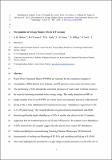| dc.contributor.author | Mahon, A.M. | |
| dc.contributor.author | O'Connell, B. | |
| dc.contributor.author | Healy, Mark G. | |
| dc.contributor.author | O’Connor, I. | |
| dc.contributor.author | Officer, R. | |
| dc.contributor.author | Nash, R. | |
| dc.contributor.author | Morrison, Liam | |
| dc.date.accessioned | 2017-08-10T14:17:47Z | |
| dc.date.issued | 2016-12-12 | |
| dc.identifier.citation | Mahon, A. M., O’Connell, B., Healy, M. G., O’Connor, I., Officer, R., Nash, R., & Morrison, L. (2017). Microplastics in Sewage Sludge: Effects of Treatment. Environmental Science & Technology, 51(2), 810-818. doi: 10.1021/acs.est.6b04048 | en_IE |
| dc.identifier.issn | 1520-5851 | |
| dc.identifier.uri | http://hdl.handle.net/10379/6698 | |
| dc.description.abstract | Waste Water Treatment Plants (WWTPs) are receptors for the cumulative loading of microplastics (MPs) derived from industry, landfill, domestic waste water and storm water. The partitioning of MPs through the settlement processes of waste water treatment results in the majority becoming entrained in the sewage sludge. This study characterised MPs in sludge samples from seven WWTPs in Ireland, which use anaerobic digestion (AD), thermal drying (TD), or lime stabilisation (LS) treatment processes. Abundances ranged from 4,196 to 15,385 particles kg-1 (dry weight). Results of a general linear mixed model (GLMM) showed significantly higher abundances of MPs in smaller size classes in the LS samples, suggesting that the treatment process of LS shear MP particles. In contrast, lower abundances of MPs found in the AD samples suggest that this process may reduce MP abundances. Surface morphologies examined using Scanning Electron Microscopy (SEM) showed characteristics of melting and blistering of TD MPs and shredding and flaking of LS MPs. This study highlights the potential for sewage sludge treatment processes to affect the risk of MP pollution prior to land spreading and may have implications for legislation governing the application of biosolids to agricultural land. | en_IE |
| dc.description.sponsorship | We acknowledge the Environmental Protection Agency of Ireland for funding this research. | en_IE |
| dc.format | application/pdf | en_IE |
| dc.language.iso | en | en_IE |
| dc.publisher | American Chemical Society | en_IE |
| dc.relation.ispartof | Environmental Science And Technology | en |
| dc.rights | Attribution-NonCommercial-NoDerivs 3.0 Ireland | |
| dc.rights.uri | https://creativecommons.org/licenses/by-nc-nd/3.0/ie/ | |
| dc.subject | Civil engineering | en_IE |
| dc.subject | Microplastics | en_IE |
| dc.subject | Sewage | en_IE |
| dc.subject | Sewage sludge | en_IE |
| dc.subject | Treatment | en_IE |
| dc.subject | Waste Water Treatment Plants | en_IE |
| dc.title | Microplastics in sewage sludge: effects of treatment | en_IE |
| dc.type | Article | en_IE |
| dc.date.updated | 2017-07-21T15:31:05Z | |
| dc.identifier.doi | 10.1021/acs.est.6b04048 | |
| dc.local.publishedsource | http://dx.doi.org/10.1021/acs.est.6b04048 | en_IE |
| dc.description.peer-reviewed | peer-reviewed | |
| dc.contributor.funder | |~|1267871|~| | |
| dc.description.embargo | 2017-12-12 | |
| dc.internal.rssid | 11841845 | |
| dc.local.contact | Mark Healy, Room Eng-1038, Civil Engineering, Col Of Engineering & Informatics, Nui Galway. 5364 Email: mark.healy@nuigalway.ie | |
| dc.local.copyrightchecked | No | |
| dc.local.version | ACCEPTED | |
| nui.item.downloads | 3620 | |


